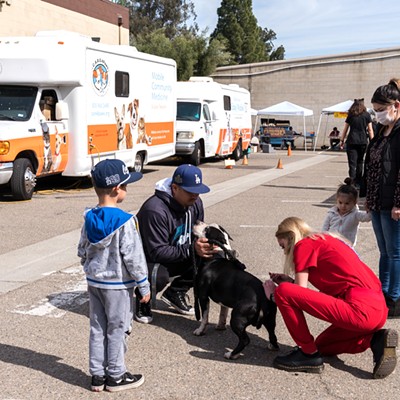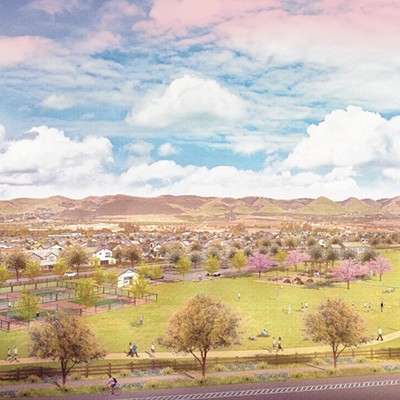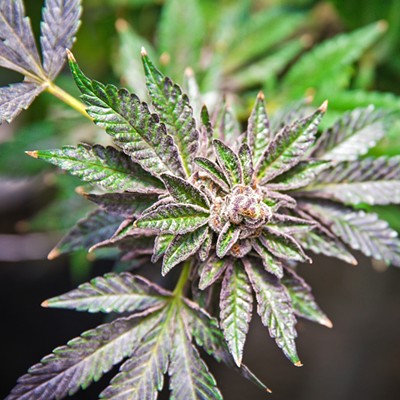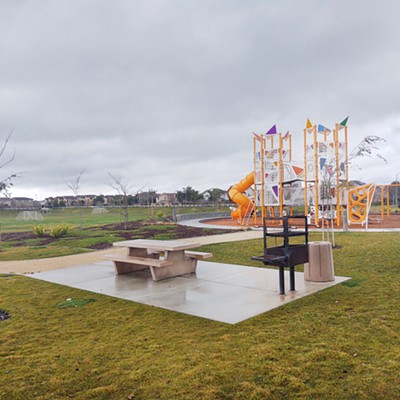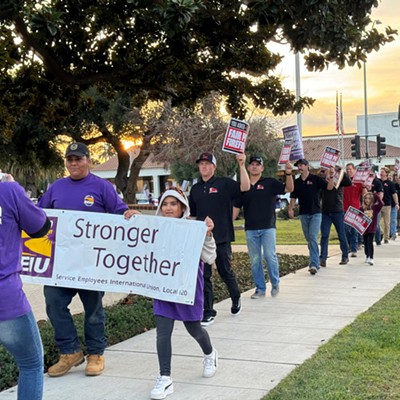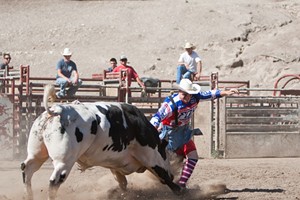
The aromatic combo of manure and not-so-fresh vegetables wafted up from the ground, mingling with the dry scents of dust and animals.
A 2,000-plus-pound black bull with what looked like foot-long white horns plodded toward a dump trailer. A nearby generator fired up, and the back end of the trailer slowly creaked its way into the air. It was around noon on May 7, and the bulls at Leffew Ranch in Nipomo were being fed a little later than normal.
Cauliflower, cabbage, broccoli, carrots, and other unidentifiable cut-up portions of vegetables began sliding toward a plastic food trough awaiting its allocation. Other bulls started paying attention and meandered over in an uneven line.
Out came the pitchforks and a shovel. Caleb Kelly, a 25-year-old bull rider from Mississippi, manned the food trough. Cody Wiggins, a 22-year-old bull rider from Florida—also Kelly’s traveling partner—hopped up into the dump trailer to help Trevor Mourer, who’s a 21-year-old bull fighter (aka rodeo clown) from Ohio, push the veggies out of the trailer.
The three have carried out the same routine for about two weeks now. Every morning they grab the beat-up, white Ford Heavy Duty Diesel F-350, hitch up the dump trailer, and head down the dirt-covered Upper Los Berros Road in Nipomo to find their way to Guadalupe. There, they load up on veggies before heading back to the Leffew Ranch.
That’s famous-in-the-bull-riding-world Gary Leffew’s ranch, where the Leffews play host to bull-riding schools, hold Sunday practice sessions, and raise bucking bulls.
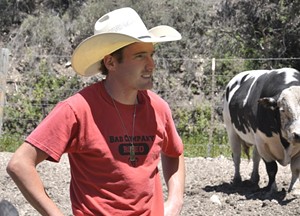
The pounds and pounds of vegetables eaten by their animals aren’t rotten; they’re just a bit past their prime, and the bulls seem to love it. One shoved his big black head into a pile of veggies up to his eyes, while another gently nibbled on half a head of cabbage that had fallen off the side of the trough.
During the first weeks of May, Leffew taught bull-riding schools in Montana and Pennsylvania, as well as attended the Vistadores Trail Ride, so the ranch needed a little extra help.
The three new ranch hands will only be helping for a short while. The Nipomo stay is just one stop on their fly-by rodeo tour of the bucking bulls of the United States. They hit the Central Coast at the end of April to help out with the bull-riding school, where they worked with 15 students for four days. In May, they fed bulls and practiced. Every night, the boys refine their riding habits on one of three bull barrels, and three afternoons a week they buck bulls. Though not all of Leffew’s bulls buck at professional rodeo levels, they’re all good for practice.
And by May 18, traveling buddies Kelly and Wiggins would be back on the road to tackle some Professional Rodeo Cowboy Association rodeos in the Midwest and on the East Coast. Mourer is sticking around the state for a little longer. He’s hoping to help out at the Santa Maria Elks Rodeo, which starts May 29, and a couple of other California rodeos before heading to San Antonio to attend a bullfighting school.
Pursuing passion
Kelly, the bull rider from Mississippi, hopped on his first bovine when he was 11 years old.
“Once I got on one time, I never stopped. It’s just a thrill,” he said. “The feeling of stepping off a bull that’s never been ridden, there’s nothing like it. … For one night, you’re the king.”

The problem for most people is that riders don’t always get to “step off” a bull with poise and grace after a successful eight-second ride. Sometimes they fall off, get bucked off, trampled on, or knocked out. And it’s not like a bull is a small animal. It’s often 2,000 pounds or more of pure wild masculinity a rider is up against, and those bulls are raring to go. Bucking is what they’re bred for.
Kelly’s curly brown hair sticks out from under his American Made cowboy hat. His black Ariat boots have teal blue stitching on them, and his ripped, faded jeans are half-tucked into his boots and half out. As he speaks, an accent from the Deep South curls around his sentences—cutting some words short and drawing others out long.
This year has been a good one for Kelly in the professional rodeo world, meaning he’s staying on bulls—with extra points for style—for the allotted eight-second ride more often than not. There’s an easy way to tell.
“My bank account usually tells me if I’m staying on enough or not,” Kelly said. “When that account gets low, it means I better start hanging on a little tighter.”
Staying on bulls wasn’t always Kelly’s forte, though. He said that when he first started riding he was taught to “hang on until you can’t hang on anymore.” That sentiment only goes so far, he explained, because there’s a right way to hold on to that bull rope and a wrong way to hang on; simply hanging on is not the way to go.
Just as often as not, Kelly found himself under the bull rather than on top of it. Or hanging off the side of one—which is what happened the first time he ever rode a “big” bull.
When pre-teen bull riders start out, they don’t hop on 1-ton monsters that buck like crazy; they take on a smaller beast with a little less back-leg-kicking, hind-quarter-lifting energy. And most bull riders don’t graduate to the upper weight class of testosterone until they’re 15 or 16 years old.
Kelly was 12.
He said someone dared him to do it. They said they would pay him $10.
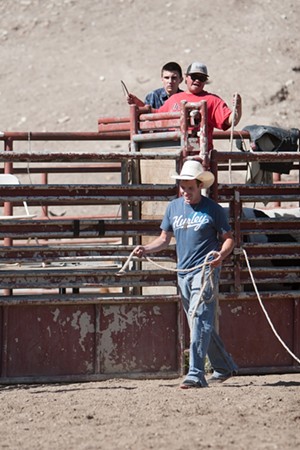
So he did it, and he didn’t stay on the big guy very long. After he got bucked off, Kelly’s hand got stuck in the bull rope. The beast was so tall that Kelly’s feet couldn’t touch the ground. That’s how he broke his wrist.
“And they didn’t even pay me,” he added with a smirk.
The injuries he’s sustained are just a part of his chosen path in life; they don’t faze him. He just shrugs his shoulders—on which he’s had two surgeries in the last three years—when he talks about injuries that would make a different person tap out of the sport. He’s shattered his left elbow, torn his ACL and meniscus, and fractured a vertebra—and those are the ones that stand out.
“RELENTLESS” is tattooed on the inside of his forearm, just below his elbow crease.
“If you find something you really love, would you not do everything possible to do it?” he said. “I’m pretty relentless.”
Head fight
Wiggins, who chases professional rodeos with Kelly, has pretty much the same attitude toward the danger and injuries caused by their chosen career. It’s part of the game.
“The first time I met him, a bull threw his head back and hit him right here,” Wiggins said as he pointed to his left eyebrow. “He held up the whole rodeo, with an ambulance and everything.”
After that bull hit Kelly’s noggin, it threw him off and stepped on the side of his face, ripping his ear off. Kelly was 15 or 16 at the time, and only the lower half of his right ear is left, which he said is really only an issue when he’s wearing sunglasses.
Wiggins is a little taller than Kelly, but similarly built, thin and small-framed. Kelly weighs in between 145 and 150 pounds at 5 feet 7 inches, while Wiggins is 5 feet 8 inches and between 155 to 160 pounds. They explained that the smaller you are, the easier it is to move around on top of a bull.
During a short practice session on Sunday, May 11, Wiggins showed off on one of the practice bulls used for riders who are learning. He was wearing red and black Nike tennis shoes with a blue Hurley shirt—not your typical riding gear.
Practice bulls aren’t the hard-charging kind you find in a rodeo arena. They’re a little less buck-happy, meant to help a rider work on form and style. Wiggins made it look easy, like he was just having a little fun, before he dismounted into the dirt and walked away with a smile.
With short, dirty-blond hair, Wiggins always has a wide grin on his face and is constantly cracking jokes in his fast-talking Southern drawl. Seriousness is not a quality he carries.
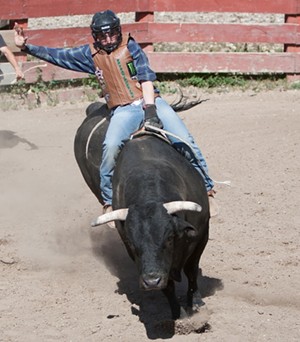
“They used to call me Mr. Potato Head in college,” he said, laughing as he turned his head to one side and pointed. “Where’s his shoulders? Did they go that way or that way?”
He’s had reconstruction work completed on both his shoulders recently. He said those injuries are definitely something he thinks about before he gets on that next bull, or while he’s straddling it in the chute.
“[You’re] thinking, ‘Can it hold up for the next bull?’” he said. “When you ride bulls, you fight your head a lot.”
It’s a solo profession: just the bull rider and his potential conquest. Mistakes and injuries from previous rides can flood back as a rider steps up to meet his eight-second match.
But Wiggins said that’s something a rider has to get over. Thinking about the past can take away from what needs to happen when that chute gate opens and the bull charges into the arena; it can overshadow those moments that need muscle memory and quick little shifts in body weight; it can be the difference between sliding off a bull successfully and ending up under a stampede of hooves.
Kelly and Wiggins agree that once that gate opens, there’s nothing to think about, and you just let your body take over. You ride, hang on, and cover the top of that bull until it’s over. Then, hopefully, you jump clear while “cowboy protection,” such as Mourer, takes over, pulls off the rope around the bull’s back legs, and herds it out of the arena.
A little different
That Sunday, a couple of riders in full gear—padded vests, boots, spurs, and what looked like a hockey helmet—made riding a bull look harder than Wiggins did. One of them, Tanner Vorst, is 15 years old.
He’s been riding since he was 12, and hasn’t graduated up to the upper weight class of bulls yet. That comes next year. Slender and tall, as he rode with one arm in the air and one on the bull rope, he started to slide off to the right side, got dumped, and fell on his chest. He didn’t cover very well—which essentially means to stay on top of the bull.
“He’s still learning,” Kelly and Wiggins said.
Tanner jumped up and dusted himself off, before his mom yelled out, “You gonna ride again?”
He shook his head. He was winded. Three rides were enough for him that day.
The Vorsts make the drive from Porterville to Nipomo as often as they can. Tanner has attended two of Leffew’s four-day bull riding schools in addition to several Sunday practice sessions. Leffew charges $25 for the first bull ride and $5 for each ride after that.
Tanner is soft spoken and doesn’t say much, but he did say he likes coming out to the ranch. It’s different from other places where he sometimes practices.
“It’s better [here] because no one’s partying here and drinking all the time,” Tanner said.
His mother, Regina, had more to say. She said she likes bringing him to Nipomo because the older riders are ones her son can look up to; they give him pointers. Regina agreed with Tanner about the drinking thing. It’s something she doesn’t see in Nipomo, whereas in places like Fresno, she said, it’s bad.
Sometimes, it’s hard for her to watch him come out of the chute, but she said it gets easier every year.
“You just kind of hold your breath and you just kind of say a prayer every time that he comes out,” she said.
Holding her breath for a brief period of time is worth the results she gets from watching her son ride. Regina laughed as she talked about how far her son has come since he took up bull riding three years ago. Tanner was bullied a lot in junior high and elementary school.
“Now, no one messes with him. They think he must be crazy,” she said with a soft laugh. “This kind of keeps him on the straight and narrow, and to be honest, he was shy—you can’t tell now.”
Contact Staff Writer Camillia Lanham at [email protected].


